NUR 230: Cultural Competency in Nursing - Diversity and Care
VerifiedAdded on 2023/04/03
|7
|1407
|330
Report
AI Summary
This report provides an overview of cultural competence in nursing practice, emphasizing its fundamental role in delivering effective healthcare. It explores the relationship between cultural competence and diversity, highlighting the importance of patient- and family-centered care. The report analyzes barriers to providing culturally competent care, such as health disparities and communication challenges, and offers recommendations for promoting health activities within diverse populations. It also addresses the need for cultural awareness, knowledge, and skills among healthcare providers, advocating for comprehensive training programs and further research to enhance cultural competence in nursing. The report concludes by stressing the significance of integrating cultural competency into nursing education and practice to ensure equitable and patient-centered care for all individuals, irrespective of their cultural background.
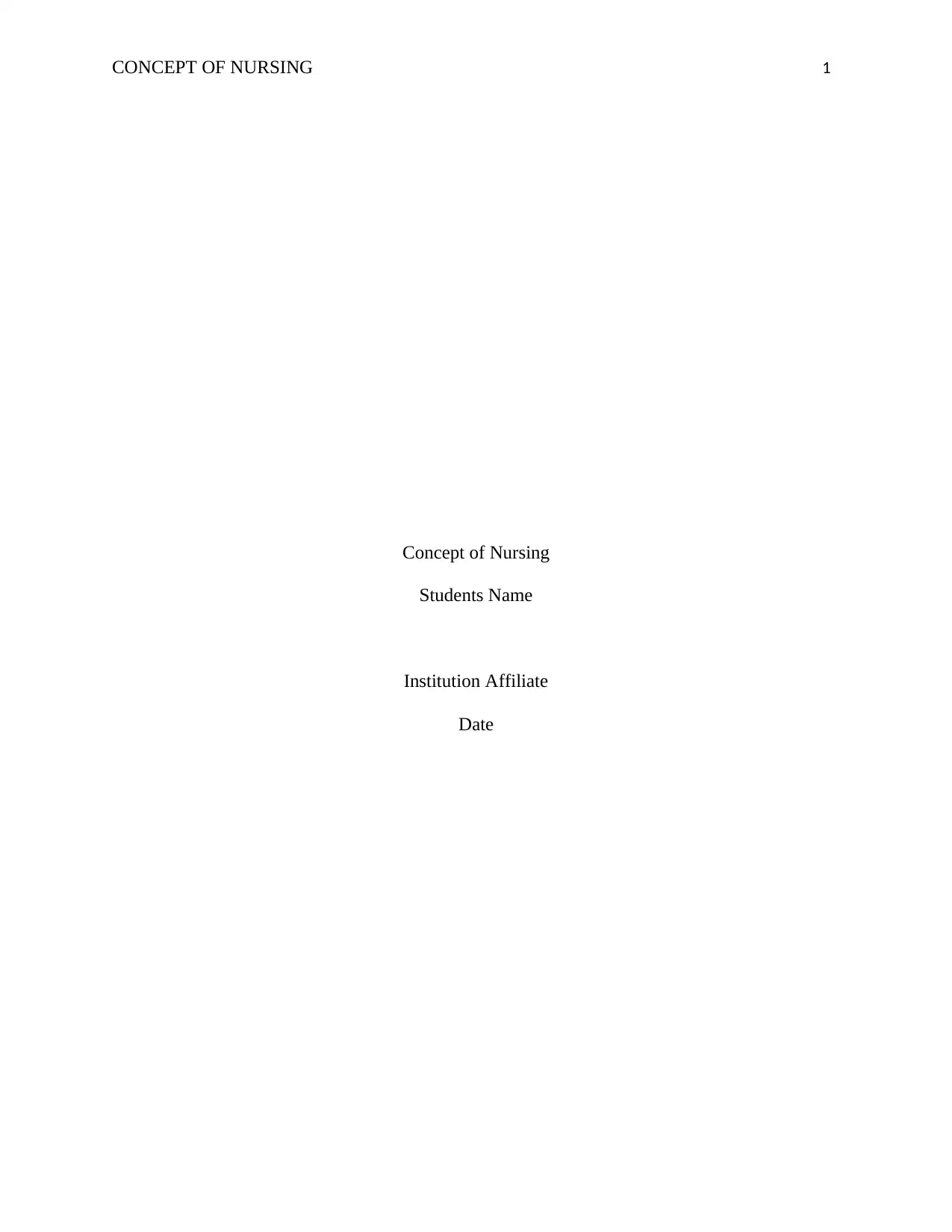
CONCEPT OF NURSING 1
Concept of Nursing
Students Name
Institution Affiliate
Date
Concept of Nursing
Students Name
Institution Affiliate
Date
Paraphrase This Document
Need a fresh take? Get an instant paraphrase of this document with our AI Paraphraser
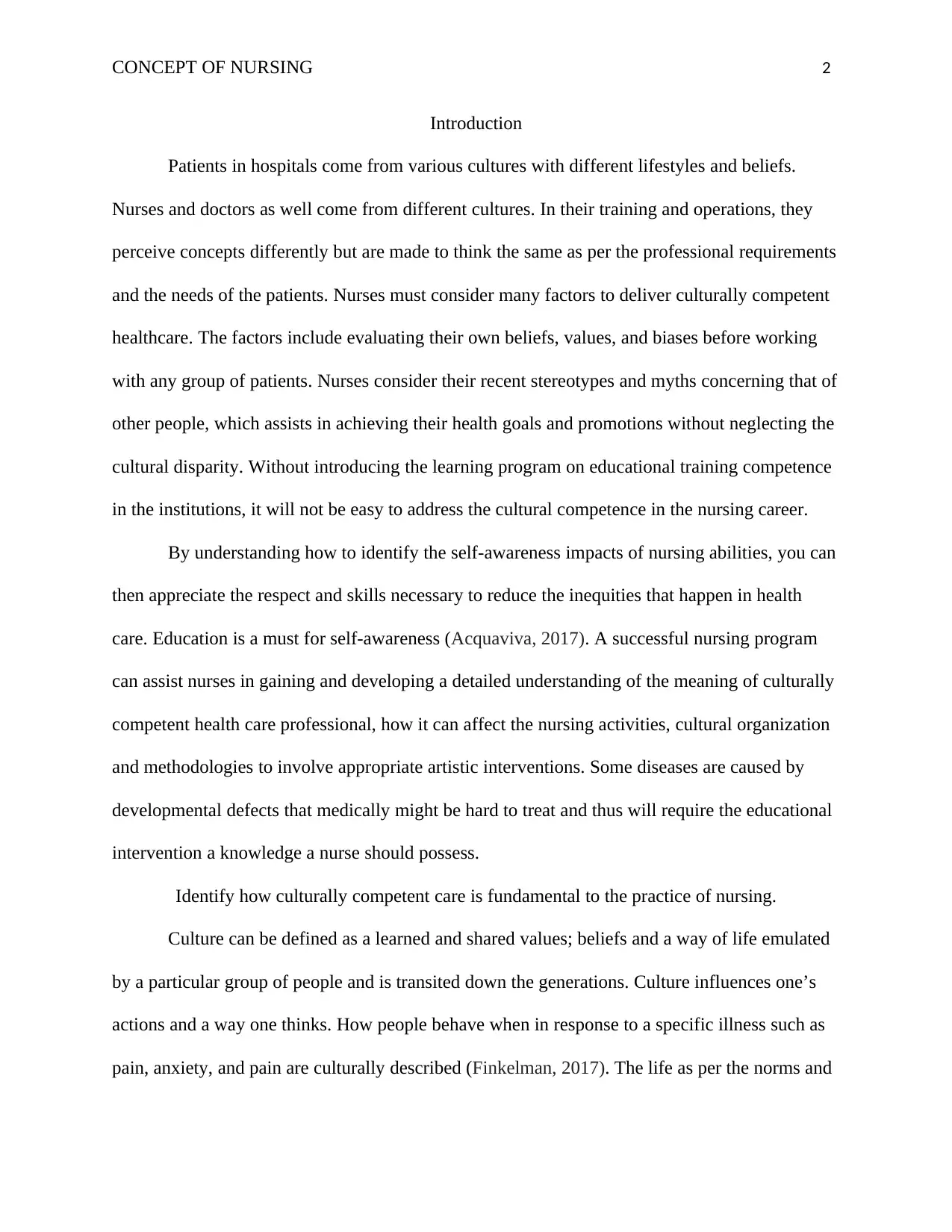
CONCEPT OF NURSING 2
Introduction
Patients in hospitals come from various cultures with different lifestyles and beliefs.
Nurses and doctors as well come from different cultures. In their training and operations, they
perceive concepts differently but are made to think the same as per the professional requirements
and the needs of the patients. Nurses must consider many factors to deliver culturally competent
healthcare. The factors include evaluating their own beliefs, values, and biases before working
with any group of patients. Nurses consider their recent stereotypes and myths concerning that of
other people, which assists in achieving their health goals and promotions without neglecting the
cultural disparity. Without introducing the learning program on educational training competence
in the institutions, it will not be easy to address the cultural competence in the nursing career.
By understanding how to identify the self-awareness impacts of nursing abilities, you can
then appreciate the respect and skills necessary to reduce the inequities that happen in health
care. Education is a must for self-awareness (Acquaviva, 2017). A successful nursing program
can assist nurses in gaining and developing a detailed understanding of the meaning of culturally
competent health care professional, how it can affect the nursing activities, cultural organization
and methodologies to involve appropriate artistic interventions. Some diseases are caused by
developmental defects that medically might be hard to treat and thus will require the educational
intervention a knowledge a nurse should possess.
Identify how culturally competent care is fundamental to the practice of nursing.
Culture can be defined as a learned and shared values; beliefs and a way of life emulated
by a particular group of people and is transited down the generations. Culture influences one’s
actions and a way one thinks. How people behave when in response to a specific illness such as
pain, anxiety, and pain are culturally described (Finkelman, 2017). The life as per the norms and
Introduction
Patients in hospitals come from various cultures with different lifestyles and beliefs.
Nurses and doctors as well come from different cultures. In their training and operations, they
perceive concepts differently but are made to think the same as per the professional requirements
and the needs of the patients. Nurses must consider many factors to deliver culturally competent
healthcare. The factors include evaluating their own beliefs, values, and biases before working
with any group of patients. Nurses consider their recent stereotypes and myths concerning that of
other people, which assists in achieving their health goals and promotions without neglecting the
cultural disparity. Without introducing the learning program on educational training competence
in the institutions, it will not be easy to address the cultural competence in the nursing career.
By understanding how to identify the self-awareness impacts of nursing abilities, you can
then appreciate the respect and skills necessary to reduce the inequities that happen in health
care. Education is a must for self-awareness (Acquaviva, 2017). A successful nursing program
can assist nurses in gaining and developing a detailed understanding of the meaning of culturally
competent health care professional, how it can affect the nursing activities, cultural organization
and methodologies to involve appropriate artistic interventions. Some diseases are caused by
developmental defects that medically might be hard to treat and thus will require the educational
intervention a knowledge a nurse should possess.
Identify how culturally competent care is fundamental to the practice of nursing.
Culture can be defined as a learned and shared values; beliefs and a way of life emulated
by a particular group of people and is transited down the generations. Culture influences one’s
actions and a way one thinks. How people behave when in response to a specific illness such as
pain, anxiety, and pain are culturally described (Finkelman, 2017). The life as per the norms and
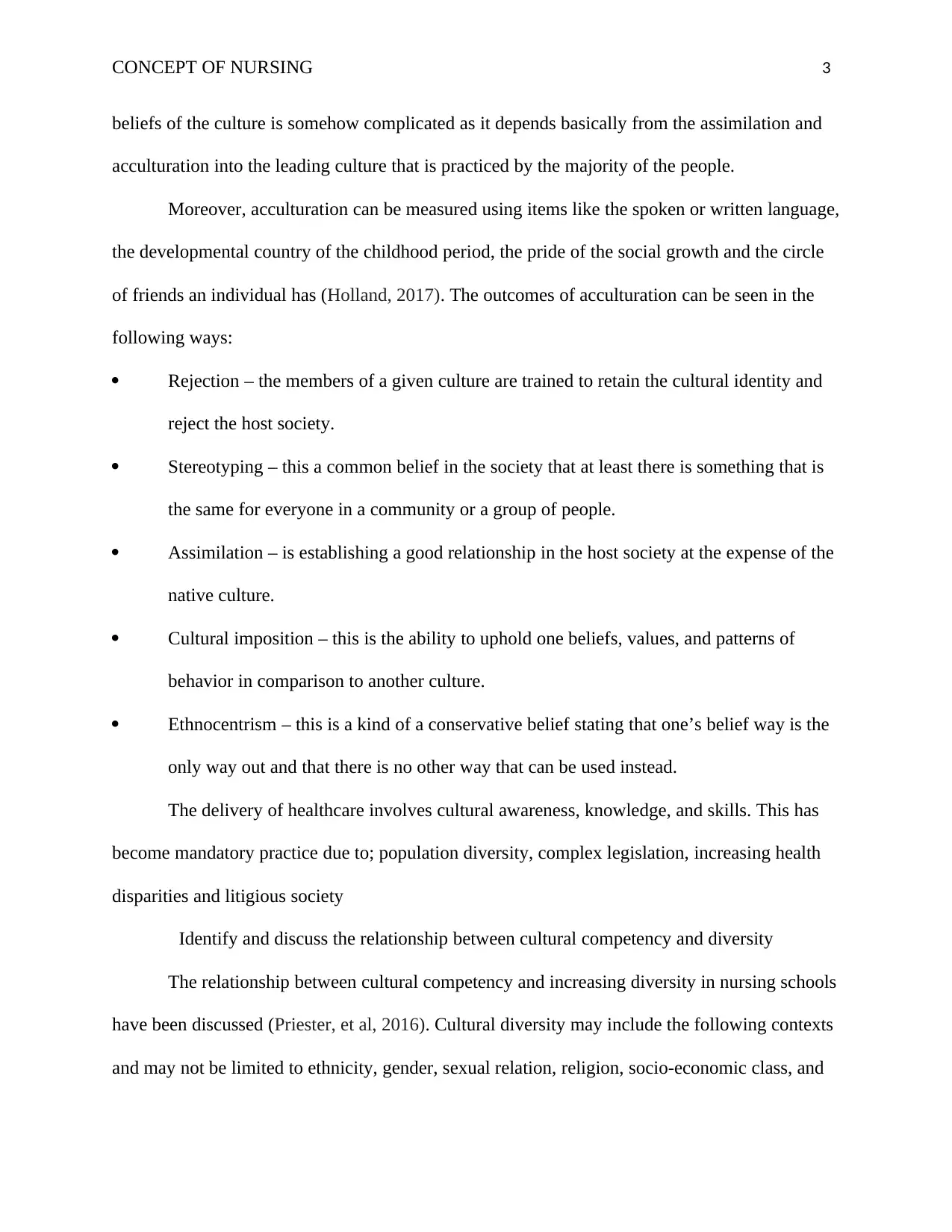
CONCEPT OF NURSING 3
beliefs of the culture is somehow complicated as it depends basically from the assimilation and
acculturation into the leading culture that is practiced by the majority of the people.
Moreover, acculturation can be measured using items like the spoken or written language,
the developmental country of the childhood period, the pride of the social growth and the circle
of friends an individual has (Holland, 2017). The outcomes of acculturation can be seen in the
following ways:
Rejection – the members of a given culture are trained to retain the cultural identity and
reject the host society.
Stereotyping – this a common belief in the society that at least there is something that is
the same for everyone in a community or a group of people.
Assimilation – is establishing a good relationship in the host society at the expense of the
native culture.
Cultural imposition – this is the ability to uphold one beliefs, values, and patterns of
behavior in comparison to another culture.
Ethnocentrism – this is a kind of a conservative belief stating that one’s belief way is the
only way out and that there is no other way that can be used instead.
The delivery of healthcare involves cultural awareness, knowledge, and skills. This has
become mandatory practice due to; population diversity, complex legislation, increasing health
disparities and litigious society
Identify and discuss the relationship between cultural competency and diversity
The relationship between cultural competency and increasing diversity in nursing schools
have been discussed (Priester, et al, 2016). Cultural diversity may include the following contexts
and may not be limited to ethnicity, gender, sexual relation, religion, socio-economic class, and
beliefs of the culture is somehow complicated as it depends basically from the assimilation and
acculturation into the leading culture that is practiced by the majority of the people.
Moreover, acculturation can be measured using items like the spoken or written language,
the developmental country of the childhood period, the pride of the social growth and the circle
of friends an individual has (Holland, 2017). The outcomes of acculturation can be seen in the
following ways:
Rejection – the members of a given culture are trained to retain the cultural identity and
reject the host society.
Stereotyping – this a common belief in the society that at least there is something that is
the same for everyone in a community or a group of people.
Assimilation – is establishing a good relationship in the host society at the expense of the
native culture.
Cultural imposition – this is the ability to uphold one beliefs, values, and patterns of
behavior in comparison to another culture.
Ethnocentrism – this is a kind of a conservative belief stating that one’s belief way is the
only way out and that there is no other way that can be used instead.
The delivery of healthcare involves cultural awareness, knowledge, and skills. This has
become mandatory practice due to; population diversity, complex legislation, increasing health
disparities and litigious society
Identify and discuss the relationship between cultural competency and diversity
The relationship between cultural competency and increasing diversity in nursing schools
have been discussed (Priester, et al, 2016). Cultural diversity may include the following contexts
and may not be limited to ethnicity, gender, sexual relation, religion, socio-economic class, and
⊘ This is a preview!⊘
Do you want full access?
Subscribe today to unlock all pages.

Trusted by 1+ million students worldwide
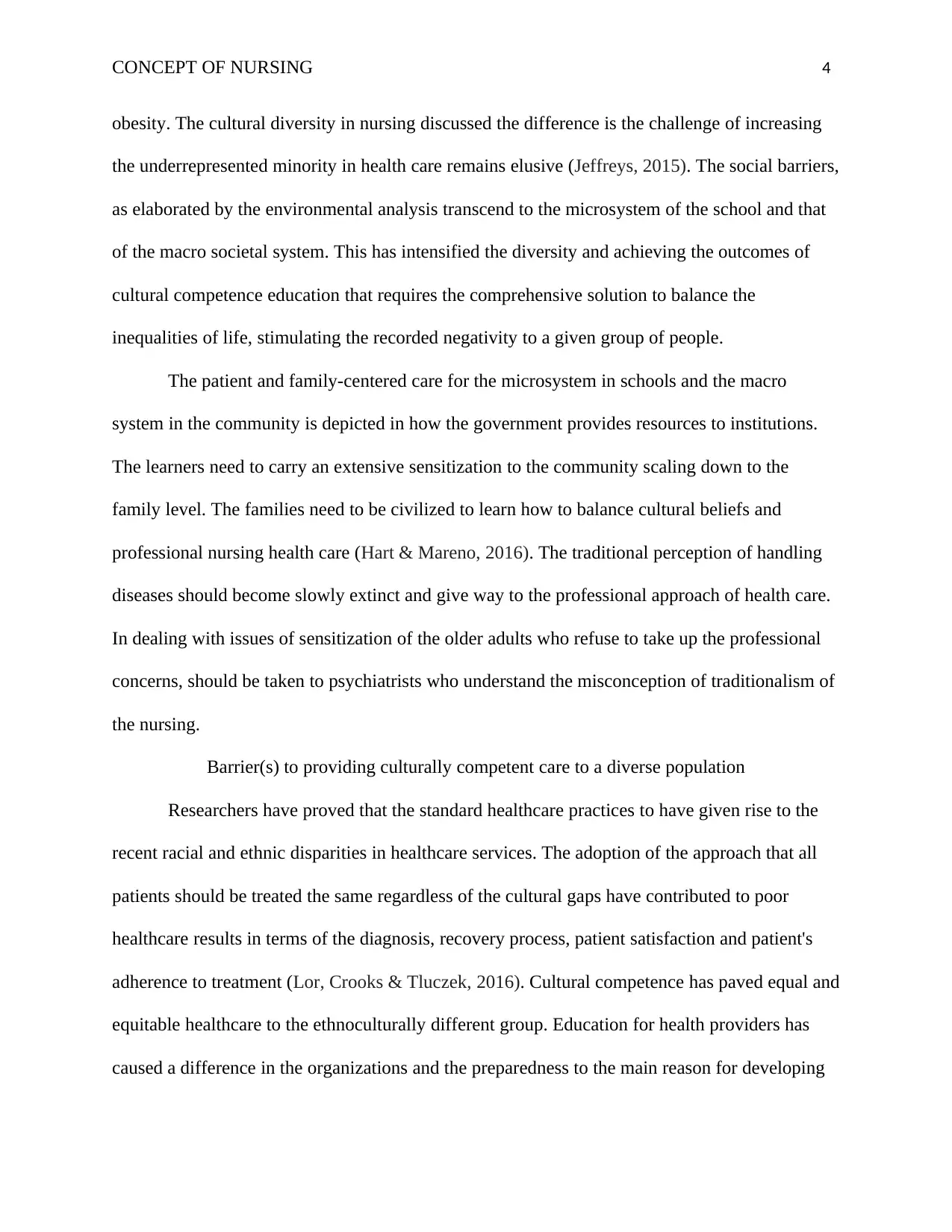
CONCEPT OF NURSING 4
obesity. The cultural diversity in nursing discussed the difference is the challenge of increasing
the underrepresented minority in health care remains elusive (Jeffreys, 2015). The social barriers,
as elaborated by the environmental analysis transcend to the microsystem of the school and that
of the macro societal system. This has intensified the diversity and achieving the outcomes of
cultural competence education that requires the comprehensive solution to balance the
inequalities of life, stimulating the recorded negativity to a given group of people.
The patient and family-centered care for the microsystem in schools and the macro
system in the community is depicted in how the government provides resources to institutions.
The learners need to carry an extensive sensitization to the community scaling down to the
family level. The families need to be civilized to learn how to balance cultural beliefs and
professional nursing health care (Hart & Mareno, 2016). The traditional perception of handling
diseases should become slowly extinct and give way to the professional approach of health care.
In dealing with issues of sensitization of the older adults who refuse to take up the professional
concerns, should be taken to psychiatrists who understand the misconception of traditionalism of
the nursing.
Barrier(s) to providing culturally competent care to a diverse population
Researchers have proved that the standard healthcare practices to have given rise to the
recent racial and ethnic disparities in healthcare services. The adoption of the approach that all
patients should be treated the same regardless of the cultural gaps have contributed to poor
healthcare results in terms of the diagnosis, recovery process, patient satisfaction and patient's
adherence to treatment (Lor, Crooks & Tluczek, 2016). Cultural competence has paved equal and
equitable healthcare to the ethnoculturally different group. Education for health providers has
caused a difference in the organizations and the preparedness to the main reason for developing
obesity. The cultural diversity in nursing discussed the difference is the challenge of increasing
the underrepresented minority in health care remains elusive (Jeffreys, 2015). The social barriers,
as elaborated by the environmental analysis transcend to the microsystem of the school and that
of the macro societal system. This has intensified the diversity and achieving the outcomes of
cultural competence education that requires the comprehensive solution to balance the
inequalities of life, stimulating the recorded negativity to a given group of people.
The patient and family-centered care for the microsystem in schools and the macro
system in the community is depicted in how the government provides resources to institutions.
The learners need to carry an extensive sensitization to the community scaling down to the
family level. The families need to be civilized to learn how to balance cultural beliefs and
professional nursing health care (Hart & Mareno, 2016). The traditional perception of handling
diseases should become slowly extinct and give way to the professional approach of health care.
In dealing with issues of sensitization of the older adults who refuse to take up the professional
concerns, should be taken to psychiatrists who understand the misconception of traditionalism of
the nursing.
Barrier(s) to providing culturally competent care to a diverse population
Researchers have proved that the standard healthcare practices to have given rise to the
recent racial and ethnic disparities in healthcare services. The adoption of the approach that all
patients should be treated the same regardless of the cultural gaps have contributed to poor
healthcare results in terms of the diagnosis, recovery process, patient satisfaction and patient's
adherence to treatment (Lor, Crooks & Tluczek, 2016). Cultural competence has paved equal and
equitable healthcare to the ethnoculturally different group. Education for health providers has
caused a difference in the organizations and the preparedness to the main reason for developing
Paraphrase This Document
Need a fresh take? Get an instant paraphrase of this document with our AI Paraphraser
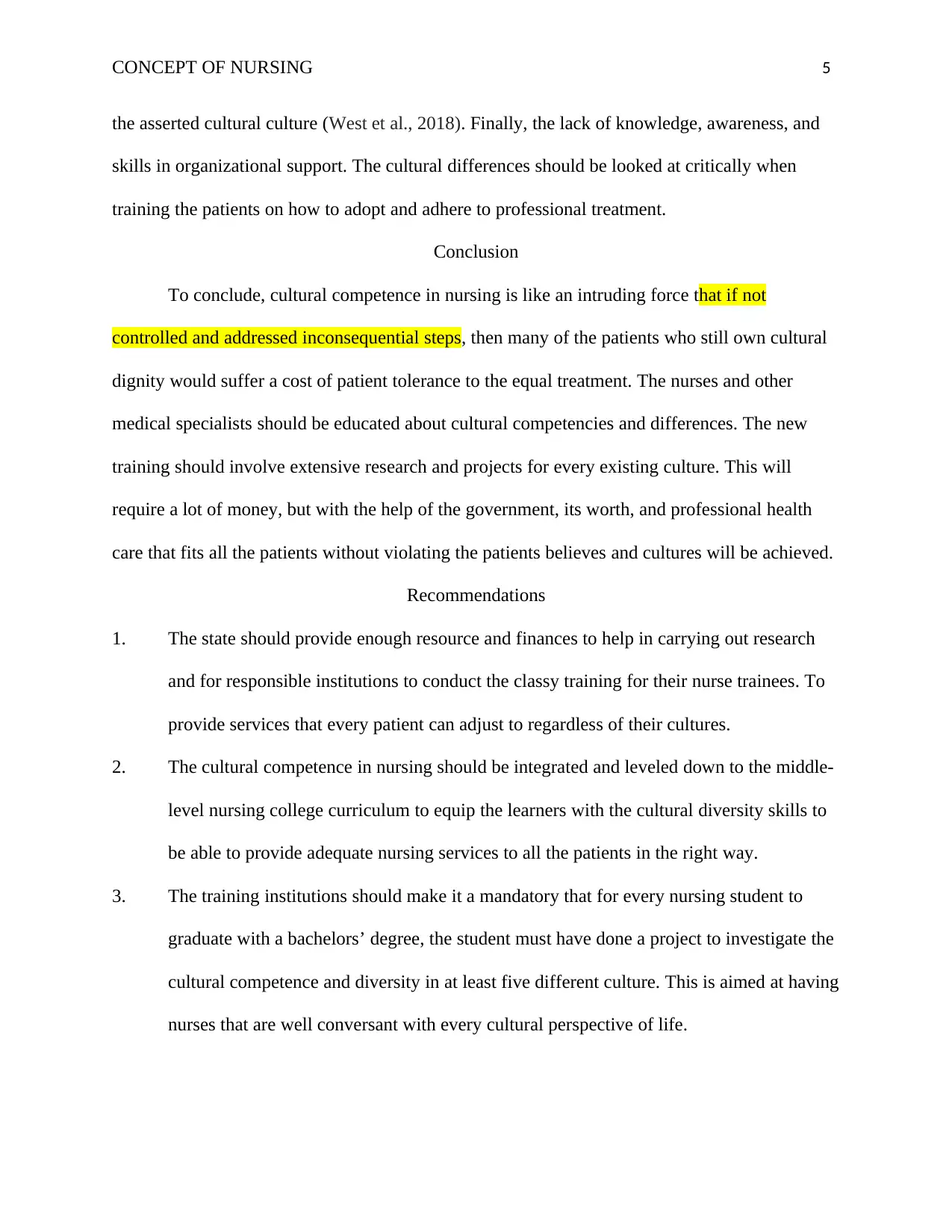
CONCEPT OF NURSING 5
the asserted cultural culture (West et al., 2018). Finally, the lack of knowledge, awareness, and
skills in organizational support. The cultural differences should be looked at critically when
training the patients on how to adopt and adhere to professional treatment.
Conclusion
To conclude, cultural competence in nursing is like an intruding force that if not
controlled and addressed inconsequential steps, then many of the patients who still own cultural
dignity would suffer a cost of patient tolerance to the equal treatment. The nurses and other
medical specialists should be educated about cultural competencies and differences. The new
training should involve extensive research and projects for every existing culture. This will
require a lot of money, but with the help of the government, its worth, and professional health
care that fits all the patients without violating the patients believes and cultures will be achieved.
Recommendations
1. The state should provide enough resource and finances to help in carrying out research
and for responsible institutions to conduct the classy training for their nurse trainees. To
provide services that every patient can adjust to regardless of their cultures.
2. The cultural competence in nursing should be integrated and leveled down to the middle-
level nursing college curriculum to equip the learners with the cultural diversity skills to
be able to provide adequate nursing services to all the patients in the right way.
3. The training institutions should make it a mandatory that for every nursing student to
graduate with a bachelors’ degree, the student must have done a project to investigate the
cultural competence and diversity in at least five different culture. This is aimed at having
nurses that are well conversant with every cultural perspective of life.
the asserted cultural culture (West et al., 2018). Finally, the lack of knowledge, awareness, and
skills in organizational support. The cultural differences should be looked at critically when
training the patients on how to adopt and adhere to professional treatment.
Conclusion
To conclude, cultural competence in nursing is like an intruding force that if not
controlled and addressed inconsequential steps, then many of the patients who still own cultural
dignity would suffer a cost of patient tolerance to the equal treatment. The nurses and other
medical specialists should be educated about cultural competencies and differences. The new
training should involve extensive research and projects for every existing culture. This will
require a lot of money, but with the help of the government, its worth, and professional health
care that fits all the patients without violating the patients believes and cultures will be achieved.
Recommendations
1. The state should provide enough resource and finances to help in carrying out research
and for responsible institutions to conduct the classy training for their nurse trainees. To
provide services that every patient can adjust to regardless of their cultures.
2. The cultural competence in nursing should be integrated and leveled down to the middle-
level nursing college curriculum to equip the learners with the cultural diversity skills to
be able to provide adequate nursing services to all the patients in the right way.
3. The training institutions should make it a mandatory that for every nursing student to
graduate with a bachelors’ degree, the student must have done a project to investigate the
cultural competence and diversity in at least five different culture. This is aimed at having
nurses that are well conversant with every cultural perspective of life.
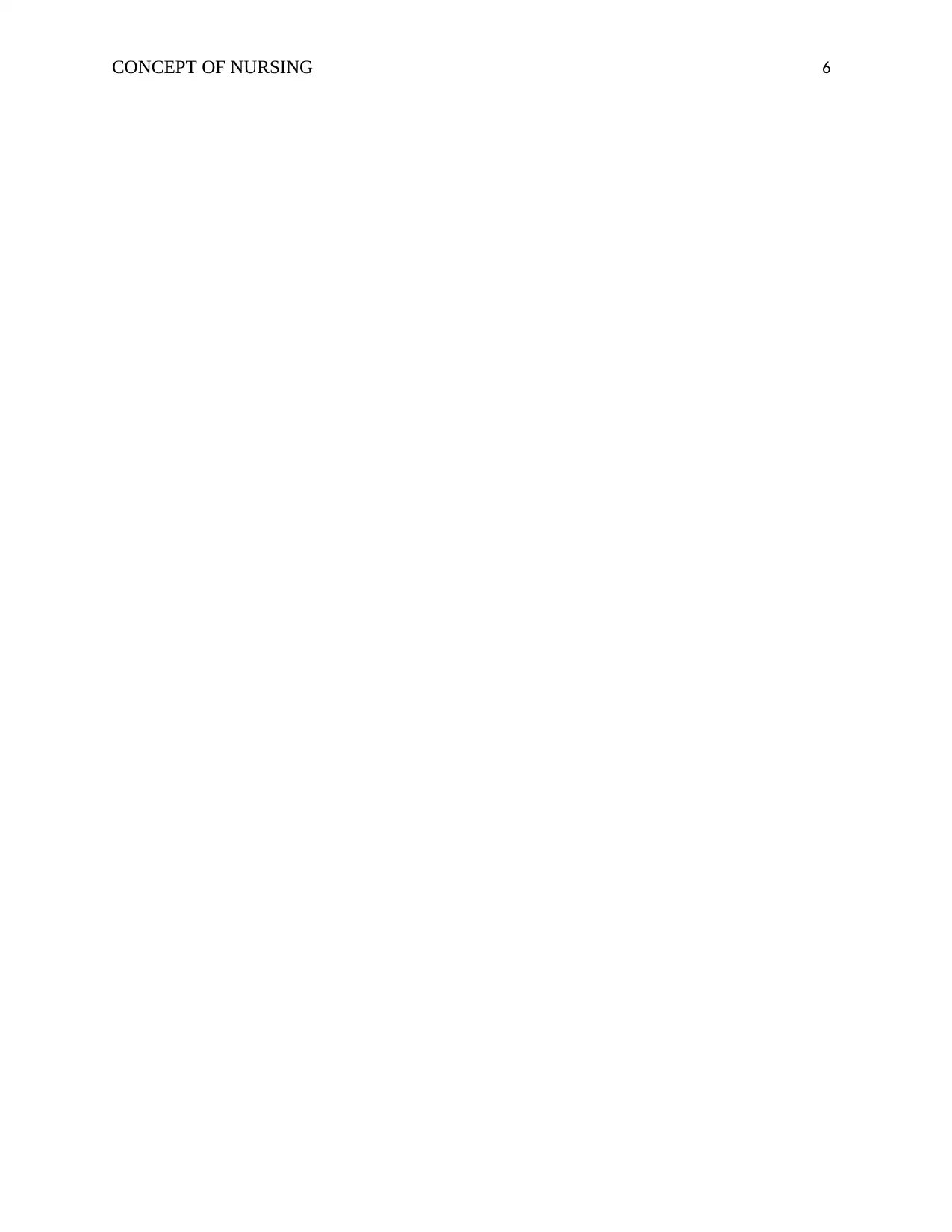
CONCEPT OF NURSING 6
⊘ This is a preview!⊘
Do you want full access?
Subscribe today to unlock all pages.

Trusted by 1+ million students worldwide
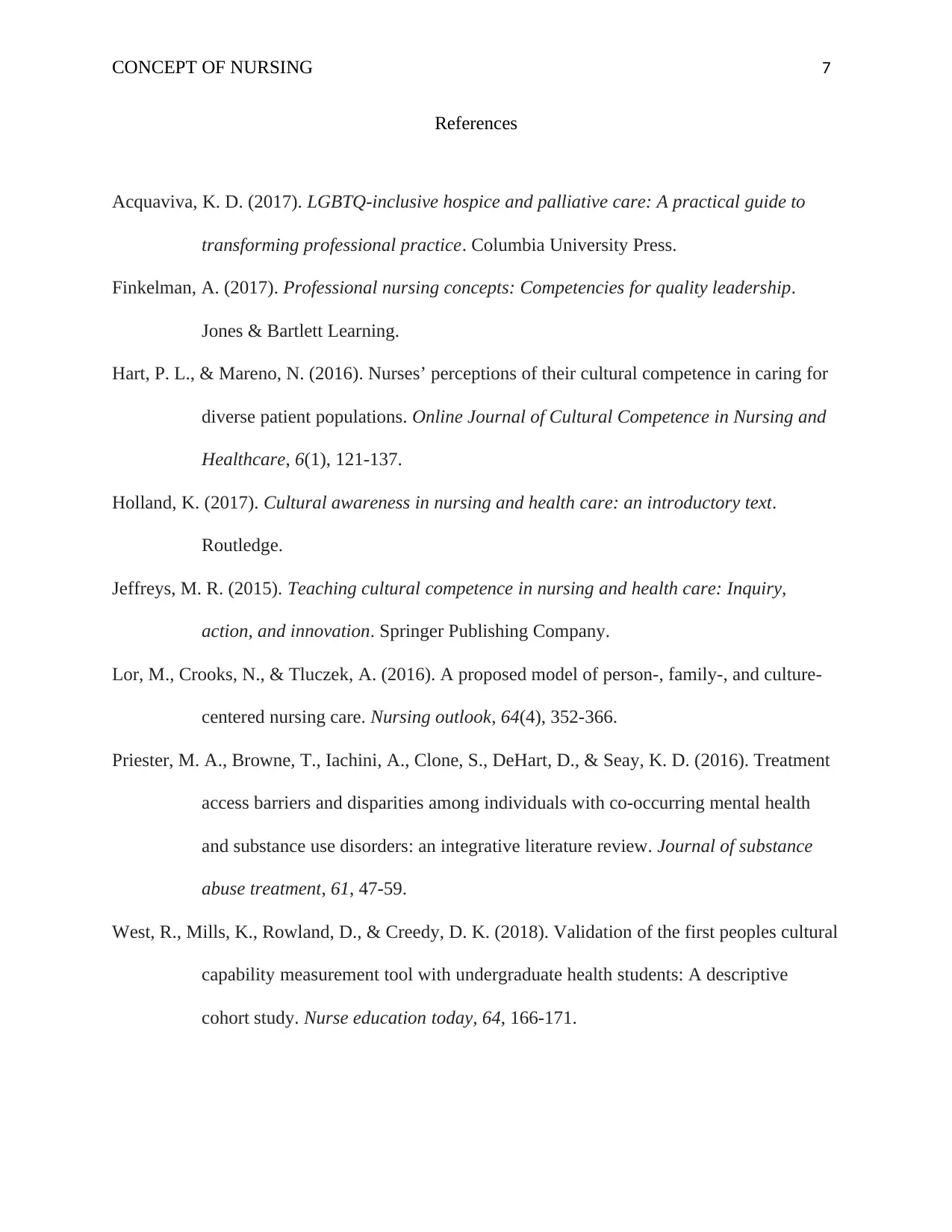
CONCEPT OF NURSING 7
References
Acquaviva, K. D. (2017). LGBTQ-inclusive hospice and palliative care: A practical guide to
transforming professional practice. Columbia University Press.
Finkelman, A. (2017). Professional nursing concepts: Competencies for quality leadership.
Jones & Bartlett Learning.
Hart, P. L., & Mareno, N. (2016). Nurses’ perceptions of their cultural competence in caring for
diverse patient populations. Online Journal of Cultural Competence in Nursing and
Healthcare, 6(1), 121-137.
Holland, K. (2017). Cultural awareness in nursing and health care: an introductory text.
Routledge.
Jeffreys, M. R. (2015). Teaching cultural competence in nursing and health care: Inquiry,
action, and innovation. Springer Publishing Company.
Lor, M., Crooks, N., & Tluczek, A. (2016). A proposed model of person-, family-, and culture-
centered nursing care. Nursing outlook, 64(4), 352-366.
Priester, M. A., Browne, T., Iachini, A., Clone, S., DeHart, D., & Seay, K. D. (2016). Treatment
access barriers and disparities among individuals with co-occurring mental health
and substance use disorders: an integrative literature review. Journal of substance
abuse treatment, 61, 47-59.
West, R., Mills, K., Rowland, D., & Creedy, D. K. (2018). Validation of the first peoples cultural
capability measurement tool with undergraduate health students: A descriptive
cohort study. Nurse education today, 64, 166-171.
References
Acquaviva, K. D. (2017). LGBTQ-inclusive hospice and palliative care: A practical guide to
transforming professional practice. Columbia University Press.
Finkelman, A. (2017). Professional nursing concepts: Competencies for quality leadership.
Jones & Bartlett Learning.
Hart, P. L., & Mareno, N. (2016). Nurses’ perceptions of their cultural competence in caring for
diverse patient populations. Online Journal of Cultural Competence in Nursing and
Healthcare, 6(1), 121-137.
Holland, K. (2017). Cultural awareness in nursing and health care: an introductory text.
Routledge.
Jeffreys, M. R. (2015). Teaching cultural competence in nursing and health care: Inquiry,
action, and innovation. Springer Publishing Company.
Lor, M., Crooks, N., & Tluczek, A. (2016). A proposed model of person-, family-, and culture-
centered nursing care. Nursing outlook, 64(4), 352-366.
Priester, M. A., Browne, T., Iachini, A., Clone, S., DeHart, D., & Seay, K. D. (2016). Treatment
access barriers and disparities among individuals with co-occurring mental health
and substance use disorders: an integrative literature review. Journal of substance
abuse treatment, 61, 47-59.
West, R., Mills, K., Rowland, D., & Creedy, D. K. (2018). Validation of the first peoples cultural
capability measurement tool with undergraduate health students: A descriptive
cohort study. Nurse education today, 64, 166-171.
1 out of 7
Related Documents
Your All-in-One AI-Powered Toolkit for Academic Success.
+13062052269
info@desklib.com
Available 24*7 on WhatsApp / Email
![[object Object]](/_next/static/media/star-bottom.7253800d.svg)
Unlock your academic potential
Copyright © 2020–2025 A2Z Services. All Rights Reserved. Developed and managed by ZUCOL.




